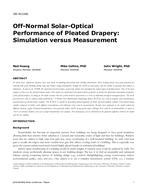Description
In recent years, significant advances have been made in modeling fenestration with shading attachments. Most shading devices have great potential for reducing both peak building cooling load and annual energy consumption through the control of solar gains, and the ability to quantify their impact is important. As part of an ASHRAE sponsored research project, several new models were developed for various types of shading devices. One of the most complex of these was the pleated drapery model. This model uses off-normal solar-optical fabric properties to predict the off-normal solar-optical properties of the pleated drapery. In doing so, the model assumes that the system could be represented as a series of uniformly arranged rectangular pleats. The work presented here aims to validate model performance. A Broad-Area Illumination Integrating Sphere (BAI-IS) was used to perform solar transmittance measurements on pleated drape samples. The BAI-IS is capable of measuring optical properties of thick and non-uniform samples. Five pleated drape samples composed of fabrics with different transmittance and reflectance were used in measurements. Results were compared to the model output for different incidence angles. Predicted transmittances were generally within ±0.05 of measured values although there could be an overprediction as much as +0.11 for normal incidence test cases of high transmittance test samples. This discrepancy can be attributed to the geometric difference between the model and the test samples.
Citation: 2016 Winter Conference, Orlando, FL, Conference Papers
Product Details
- Published:
- 2016
- Number of Pages:
- 8
- Units of Measure:
- Dual
- File Size:
- 1 file , 890 KB
- Product Code(s):
- D-OR-16-C055




